Table Of Content

This research forms the foundation of informed design decisions and reduces the risk of costly revisions later on. Similar to reverse thinking, the worst possible idea technique is great for putting the group at ease and removing creative blocks. Finally, you’ll think about how these ideas are connected, depicting said connections with lines and curves—resulting in a visual map. Developed by Tony Buzan in 1972, mindmapping is a visual ideation technique that encourages you to draw connections between different sets of ideas or information. In putting these assumptions to the test, you can determine what characteristics are really necessary, or which solutions could be used instead. As we know, challenging assumptions is crucial to breaking conventional thought patterns and coming up with new ideas.
What Tasks Will You Perform as a Product Designer?
Design thinking is more about exploring and defining the right problem and solution, whereas agile is about efficiently executing and delivering a product. Both methodologies rely heavily on collaboration among cross-functional teams and encourage diverse perspectives and expertise. The organization must be able to generate revenues and profits from the solution. The viability lens is essential not only for commercial organizations but also for non-profits. Governs the storage of data necessary for maintaining website security, user authentication, and fraud prevention mechanisms. “After several iterations, we might get something that works, we validate it with real customers, and we often find that what we thought was a great solution is actually only just OK.
What is design thinking, and how do we apply it?
Brainstorm a range of crazy, creative ideas that address the unmet user needs identified in the define phase. Give yourself and your team total freedom; no idea is too farfetched and quantity supersedes quality. Design thinking can seem like a massive undertaking, but it’s an accessible and adaptable method for all professionals who recognize the value of user-centric, solutions-based innovation. With your problem statement or question defined, you can use observations to think of potential solutions. Here’s what you need to know about the design thinking process and how you can apply it. Here, you’ll review design decisions to see how well you evaluated the end user’s needs and how effective your final design was.
Design Thinking: A Real-World Application
Large companies, for instance, tend to hire specialist designers, so they often have specific roles such as “User Researcher” and “Visual Designer”. Small and medium-sized companies, on the other hand, tend to prefer generalists and will have roles such as “UX Designer” or even “UI/UX Designer”. Always carefully read the job description of an opening before you apply, and make sure it’s a role that you are able and willing to perform. With developers, UX designers ensure that their designs are technically feasible. They provide detailed design specifications and work alongside developers to translate these designs into functional software.

It examines the psychology of everyday objects and experiences, and highlights the importance of user-centered design. When UX professionals understand how people perceive and engage with the designed world, they can create more intuitive, meaningful, and satisfying digital experiences. This publication is highly influential as it introduced the concept of contextual inquiry, a user-centered design method that involves observing and interviewing users in their natural environment. It has become a cornerstone of the UX design process, helping teams develop a deep understanding of user needs and behaviors. Wireframes play a critical role in the UX design process by serving as a blueprint for the layout and functionality of a website or application.
Design and the circular economy – deep dive - ellenmacarthurfoundation.org
Design and the circular economy – deep dive.
Posted: Thu, 19 Oct 2023 05:44:40 GMT [source]
A designer’s job isn’t as simple as slapping together some pretty graphics. They need to juggle aesthetics with functionality while keeping technical limitations into account too – kind of like cooking gourmet food over a campfire. Through these conversations, we identify patterns and trends that inform persona creation – fictitious but grounded representations of segments within our target audience.
The main goal of a problem statement is to guide designers working on possible solutions for this problem. A problem statement frames the problem in a way that easily highlights the gap between the current state of things and the end goal. It requires many different viewpoints from designers, future customers, and other stakeholders.
The End Goal of Design Thinking: Be Desirable, Feasible and Viable
Adding a tailored design thinking process to your workflows can address these issues. Once research into the problem has been conducted and an idea of what solutions have failed in the past has formed, it’s time to define the problem in human-centric terms. This means looking at it from the user’s perspective, rather than the designer’s or company’s viewpoint. Insurance firm MassMutual used a design thinking approach to tackle the challenge of getting young adults to purchase life insurance.
Brainstorming is one of the oldest tricks in the book when it comes to generating new ideas as a group. In a brainstorming session, you verbally bounce ideas off of each other in the hopes of finding a blended solution. An analogy provides a comparison between one thing and another, serving as a means of explanation or clarification. The analogy technique compares your situation—or design challenge—to something you are familiar with, enabling you to look at the problem in a new light and consider possible solutions. Well, consider the wording “how might we…”; it suggests that a solution is possible, but doesn’t give any hints as to what that solution might be.
Taking into consideration technologically feasible and viable possibilities business-wise, design thinkers might say “I have a prediction about the future”. By applying a design thinking approach, it’s possible to try these ideas in advance by showing them to the users and testing them (prototyping). During testing, the most important thing is to try the “prediction” with the right users, who can provide reliable and valid feedback according to which the prototype can be modified. This way, design thinkers can turn the predicted future to the past and find a competitive advantage.
MJV Innovation's Design Thinking Book Ranked By Forbes as Top Read - Adweek
MJV Innovation's Design Thinking Book Ranked By Forbes as Top Read.
Posted: Tue, 06 Feb 2024 08:00:00 GMT [source]
You can expect additional iterations and modifications to the solution that entail returning to a previous stage. Continue refining until you find a successful solution and implement it. Design thinking is an approach to problem-solving and innovation that’s both user-centric and solutions-based—that is, it focuses on finding solutions instead of problems. In the testing phase, you’ll look for flaws in the design, gather user feedback, and get input from other stakeholders. Some companies may want to break out the testing part into separate stages.
The team then thinks about solutions to satisfy these needs from the end user’s point of view. These prototypes can be shared and tested within the team itself, in other departments or on a small group of people outside the design team. This influential book explores how design shapes our interactions with the world around us, providing insights that are applicable to digital product design as well.
And user feedback is what allows products to really solve the problems they were designed to solve. For example, initially a chatbot could be manned by actual people until user needs are understood. The ideation phase of any design project can be one of the most creative and rewarding components. Ideation sessions should include all the members of your design team as well as other stakeholders who can offer different perspectives on the same problem. GE Healthcare product designer Doug Dietz was shocked to learn that 80% of children needed to be sedated in order to undergo an MRI.
Notice the many parallels between Laura’s advice for designers on agile teams and the mindsets of design thinking. The methodology emphasizes collaboration and a multidisciplinary approach throughout each phase to ensure solutions are innovative and deeply rooted in real human needs and contexts. More than a process, the Head, Heart and Hand framework outlines the different roles that designers must perform to create great results.
While his team had created an innovative new MRI machine, they didn’t address that particular issue because they hadn’t looked at it from the perspective of a child. When they finally did, and added colorful graphics to the machine and a story to the experience, only a fraction of one percent of kids had to be sedated for the tests. If users have tried a solution that has failed, it’s best to find out early in the process. Revealing this information through user interviews and other research helps prevent designers from repeating the same unsuitable solution.












